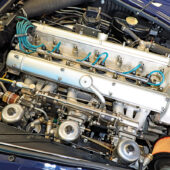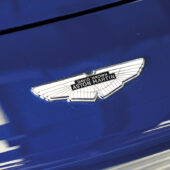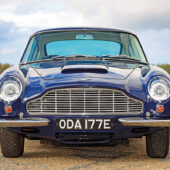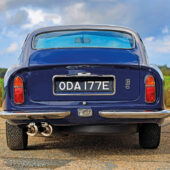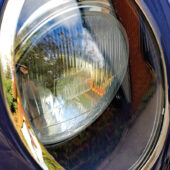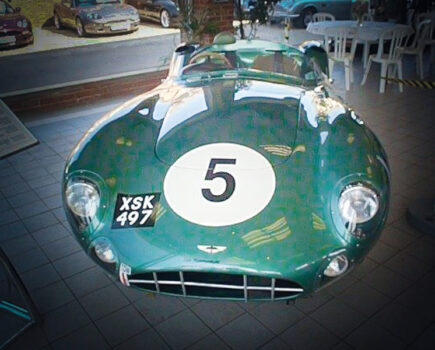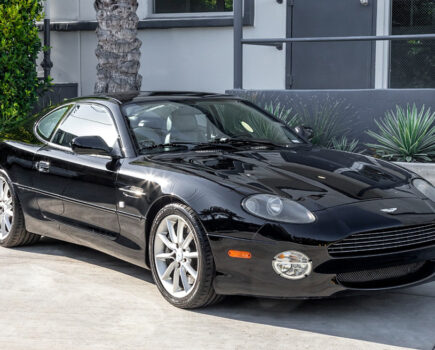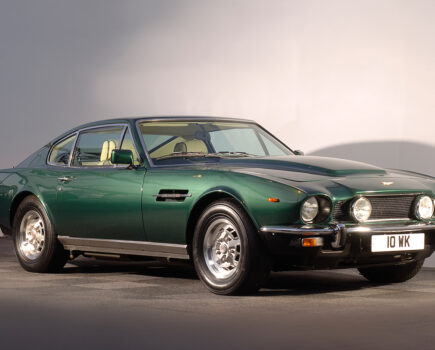The Aston Martin DB6 boasts extra space, luxury and sophistication over its similarly prestigious predecessors. Here’s how to buy a great one
Words and images: Richard Gunn
One of the many contradictions of the classic car world is that the earlier and less-developed a model it is, the more desirable it seems to be to enthusiasts. That’s especially true of the DB4, DB5 and DB6 ranges which, although distinct types in their own right, are all clearly closely related on Aston Martin’s evolutionary path. The three machines share a commonality of styling and mechanical layout plus, of course, awesome performance and seductive glamour, which echoes down from the first DB4 of 1958 through to the final Aston Martin DB6 of 1970.
Looking at the cars dispassionately, the Aston Martin DB6 is arguably the best of the bunch. It took many of the best ingredients of the previous machines and improved on them, while still retaining their overall appearance. The aerodynamics were improved, while a lengthened wheelbase gave more space inside. Power steering became available, as did air-conditioning, and fuel-injection came along towards the end. And the DB6 generally felt plusher and more lavish, indulging the driver with bigger and better instrumentation, and passengers with more comfortable seats.
However, when it comes to matters Aston Martin, being dispassionate isn’t really an option. And so the DB4 will always be better regarded as the more desirable because it was the first of the breed, has the most purity, and is so bound up with the company’s motorsport heritage. As for the DB5, it’s now saved the world so many times in the hands of Sean Connery, Pierce Brosnan and Daniel Craig that it occupies a position in the British national consciousness that is insurmountable. This all leaves the Aston Martin DB6 somewhat overshadowed in the hierarchy, although the good news for buyers is that it also makes it the most affordable of the breed. That said, as with anything Aston Martin, ‘affordable’ is a very relative term here.
The Aston Martin DB6 formally entered the world in October 1965 at the Earl’s Court Motor Show. It was clearly a development of the DB5 shape, after Touring of Milan (the Italian carrozzeria behind the DB4) had its proposals for a DB5 replacement turned down. Wind tunnel testing proved that there was considerable scope for improving high-speed stability, with the eventual solution being the adoption of a Kamm tail abruptly ending the lengthened DB5 chassis. The Superleggera tubular construction process was also dispensed with, in favour of a framework of folded box sections. Other recognition points were a raised roofline, steeper windscreen and split quarter bumpers. Inside, power steering and air conditioning were optional extras, as was a Borg-Warner three-speed automatic for those who didn’t want the five-speed manual ZF transmission, although the auto ’box wasn’t at all well-regarded.
Before long, the standard 282bhp DB6 was joined by the 325bhp Aston Martin DB6 Vantage model with three Weber carburettors instead of SUs, plus a high compression ratio cylinder head. In addition, there was also the Aston Martin DB6 Volante – Aston Martin-speak for a convertible. The first 37 used a shortened DB5 chassis with a DB6 nose, but in 1966 the al fresco Aston became fully DB6-based. That same year, coachbuilder Harold Radford built seven shooting-brake estate cars, while FLM (Panelcraft) Ltd completed a further three to an alternative design.
By 1969, the Aston Martin DBS – which would eventually supersede the DB6 – had been on sale for two years. Nevertheless, there was a final flowering of the DB6 in the form of the Mk2 (which, at one point, was going to be called the DB7; badges were even made up for it). The main differences were the flared wheelarches over wider wheels and an optional AE Brico fuel-injection system, which proved unreliable and was only fitted to 46 cars. Many parts from the DBS were also shared with the MkII.
In November 1970, production of the Aston Martin DB6 Mk2 ceased, although examples continued to be sold new into early 1971. Over the course of five years, a total of 1567 saloons and 215 Volantes had been produced. Today’s survival rate is impressive even by supercar standards of the 1960s; but what should you be looking for in your quest for the ideal DB6?
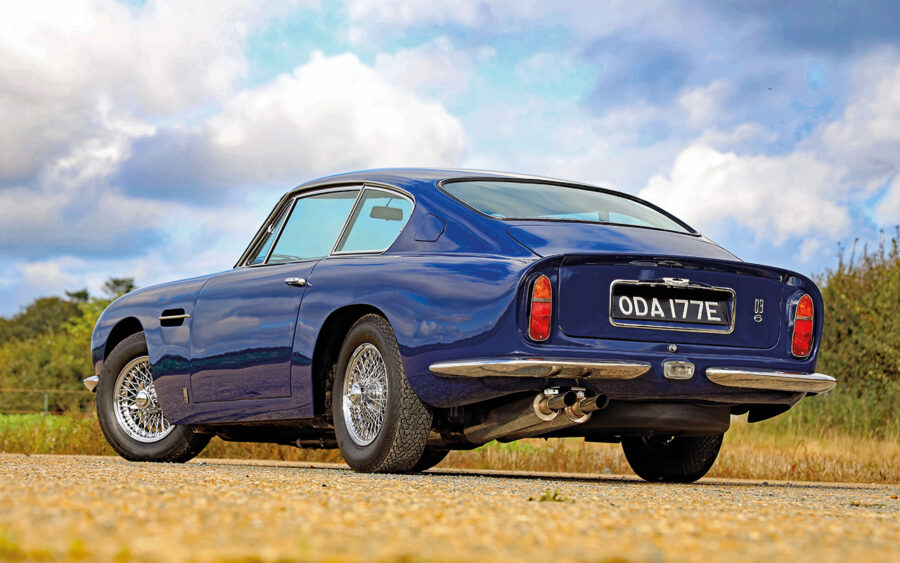
Bodywork
Because they don’t have the same Superleggera construction of previous cars, DB6s are stronger. However, with a combination of aluminium and steel construction, you do have to keep an eye out for two different types of corrosion.
Rust affects the steel at the foot of the bulkhead, the jacking points and side members. The box sections (sills) between each wheel also fall victim to ‘tinworm’, but they’re clothed in aluminium, so any problems are difficult to see. However, if the area around the jacking points is sagging, it probably means the metal here is weak. The upper assembly for the rear suspension Watt linkage is behind the back seat, and should be examined for rot. It often hosts rot that goes unnoticed until issues are very advanced. Bumper supports are vulnerable, so are the door hinge mountings and the pedal box.
If water gets into the boot, it will start to pool, especially around the wheelarches, leading to rot. Don’t forget to lift out the spare wheel to see what lies underneath in the well. Under the bonnet, vulnerable spots are the area around the washer bottle, along with the master cylinder pedestals. Brake and clutch fluid does them little good.
Turning to the aluminium, any bubbles on the body should sound alarm bells, with the potential for an electrolytic reaction occurring with the steel underneath. It’s likely to be much worse under the surface. Such issues usually strike around the rear valance and door bottoms. Look out for filler as well, which will show up as rough areas or patches of paint in a slightly different shade. Aston Martin never used filler, unlike certain other exotic supercar manufacturers; if do come across some, it shouldn’t be there and natural body flexing may eventually cause it to crack or even fall out.
If you’re looking at a Volante, don’t forget to have a close look at the condition of the hood. If water has got in, whether through leaks or unexpected showers, it may try to escape by attacking the attacking the floorpan. The rear section of the cabin is the most likely spot for this to occur.

Engine and transmission
Rebuilding an Aston Martin engine will cost a fortune, so a good service history is crucial. Oil changes every 2500 miles are advisable, with timing chain replacement every 60,000 miles. Any coolant will need to be alloy-engine sympathetic, too. Oil pressure of around 100psi on a warm car under way is a healthy sign; if you’re seeing about 50psi and you don’t think there’s a problem with the gauge, then all is not well under the bonnet. Overheating can occur, thanks to blocked up waterways around the iron cylinder liners. Silt can collect at the back of the engine, as the water pump is at the front. If the car you’re interested in heats up very quickly from cold when idling, this is likely to be the symptom. Another cause of hot-running is coolant escaping through the liner bleed apertures on the right-hand side of the engine, so do have a look at this area. If you also see oil, then the coolant and oil are mixing due to a faulty lower O-ring seal.
While an electric fan is a wise fitment, it can be used to mask issues. One that stays on all the time is trying too hard to keep an engine cool, and should be regarded with suspicion.
You’re unlikely to find a DB6 fitted with the AE Brico fuel-injection system, as it was fitted to just 46 MkII cars, and its unreliability meant that many were subsequently converted back to carburettors. If you do come across one, however, and it’s running badly or misfiring, it’s best to walk away. The carburettor cars – whether with SUs or Vantage-spec Webers – are a much better proposition, although getting all three perfectly balanced can be a fine art. Converting from SUs to Webers is a popular upgrade.
The DB6’s ZF five-speed gearbox is tough (with a heavy clutch) but, eventually, synchromesh cones and bearings will start to wear – although sorting them out is relatively simple. More of an issue is excessive noise or jumping out of gear, as a rebuild is likely to be required. The gearboxes give their best when fully warmed up; like many classic sports cars, they’re baulky when cold.
Automatic transmissions tend to sap power and are slow around mid-range, and so they’re not well-liked. That said, they don’t have too many reliability issues. If they change up and down smoothly, there’s no excess noise and the kickdown functions properly, then all should be well.
Differential wear will show up as complaining bearings and backlash, requiring reconditioning or replacement. However, some diff whine is likely as par for the course.

Suspension, steering and brakes
The front suspension trailing arms mountings should be checked from underneath, as rust can cause them to detach. Other possible problems are the sockets where the rear arms of the lower front wishbones attach, as well as deteriorated steering rack straps. Its rubber mountings bushes also go; excess movement between the chassis and the rack when driving points to this.
In general, a DB6’s steering should be sharp with little play. Excessive wander is likely to be worn suspension bushes. Dodgy trailing arm bushes will reveal themselves if you reverse the car quickly and the tail lifts. But it could also be that the Watt linkage to the axle is working loose. Either way, further investigation will be necessary.
Interior and trim
Don’t expect a tired interior to be cheap to rectify; putting right flaws with the Connolly leather interior will cost many thousands, although it does wear well when properly cared for. Some patina can be a welcome sight, like a well-established traditional gentleman’s club.
If fitted, try the air conditioning, along with all the switches. While they’re not that prone to wearing out, some of them can be difficult to source.
Make sure you try the electric windows as well, as they’re not known for their reliability. If they go up and down only slowly, it suggests that the motors are failing.
As previously mentioned, you should also have a look around the driver’s pedal cluster for signs of rust setting in.

Aston Martin DB6: our verdict
Buy an Aston Martin DB6 and you immediately join a very exclusive club. Ownership of a 1960s Aston Martin is something that very few people get to enjoy, and it will make you the envy of everybody else. Cars like this never go out of style, never look dated, never look anything less than utterly beautiful. They are among the elite, not just of British classics but of any classics from any country.
The DB6 is more civilised, refined and better-behaved than its predecessors, but it’s also just as good looking. Perhaps even more crucially, it’s also many thousands of pounds cheaper. While you’ll still need to be affluent to afford one, the running and maintenance costs will still be around the same as for a DB4 or DB5. As perverse as it may sound, a DB6 is a money-saving option.
However, you still need to go into DB6 ownership with eyes – and wallet – wide open. Buying one is the first major expense; from there, these thoroughbreds will continue to demand care and attention. They can’t be run on a budget, and if you start skimping on things, then even bigger bills will soon start to mount up.
For all its needs though, the Aston Martin DB6 is still an immensely rewarding, hand-built masterpiece that’s just as much an automotive work of art as awe-inspiring grand tourer. If you can afford to buy one, why wouldn’t you?




